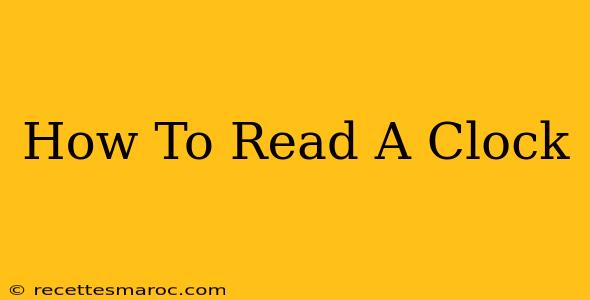Learning to tell time is a fundamental life skill. Whether you're helping a child understand the concept or need a refresher yourself, this guide will walk you through how to read a clock, covering both analog and digital clocks.
Understanding Analog Clocks
Analog clocks use hands to indicate the time. There are three main hands:
- The Hour Hand: This is the shortest hand and shows the hour.
- The Minute Hand: This is the longer hand and shows the minutes.
- The Second Hand: This is the longest hand and shows the seconds (often a thinner hand).
Reading the Hour Hand
The hour hand points directly at the number representing the hour only when the minutes are exactly zero. For example, when the hour hand points directly at the "3," it's 3:00. However, as the minute hand moves, the hour hand gradually moves towards the next number.
Reading the Minute Hand
The minute hand moves around the clock face in increments of five minutes. Each number on the clock represents five minutes. To determine the minutes, count the number of spaces the minute hand has passed since the last hour marker. For instance, if the minute hand points to the "2," that's 10 minutes (2 x 5 minutes).
Putting it Together: Reading the Time
Let's say the hour hand is between the "2" and "3," and the minute hand is pointing at the "8."
- The hour: The hour hand is past the "2," so it's after 2 o'clock.
- The minutes: The minute hand is pointing at the "8," which represents 40 minutes (8 x 5 minutes).
- The time: Therefore, the time is 2:40 or twenty to three.
Mastering Digital Clocks
Digital clocks display the time using numbers. They're generally easier to read than analog clocks, showing the hours and minutes clearly separated, like "10:35". Often, seconds are also displayed.
Practice Makes Perfect!
The best way to learn how to read a clock is through practice. Try these exercises:
Analog Clock Practice
- Draw your own clock: Create a clock face with numbers and practice placing the hands at different times.
- Use a real clock: Set an alarm clock and observe the movement of the hands as time passes.
- Play online games: There are many online games designed to help you practice telling time on analog clocks.
Digital Clock Practice
- Set a timer: Use a digital timer to observe how the numbers change as time passes.
- Look at various digital clocks: Pay attention to the different formats used on different devices (e.g., 12-hour vs. 24-hour formats).
Troubleshooting Common Challenges
- Understanding "half past" and "quarter past/to": "Half past" means 30 minutes past the hour. "Quarter past" is 15 minutes past the hour, and "quarter to" means 15 minutes before the hour.
- 12-hour vs. 24-hour clock: Familiarize yourself with both formats to avoid confusion. The 24-hour clock avoids ambiguity by representing times from midnight to noon with numbers 00:00 to 12:00, and from noon to midnight with numbers 13:00 to 23:00.
By following these steps and practicing regularly, you’ll soon be a clock-reading pro! Remember, patience and persistence are key to mastering this essential skill.

